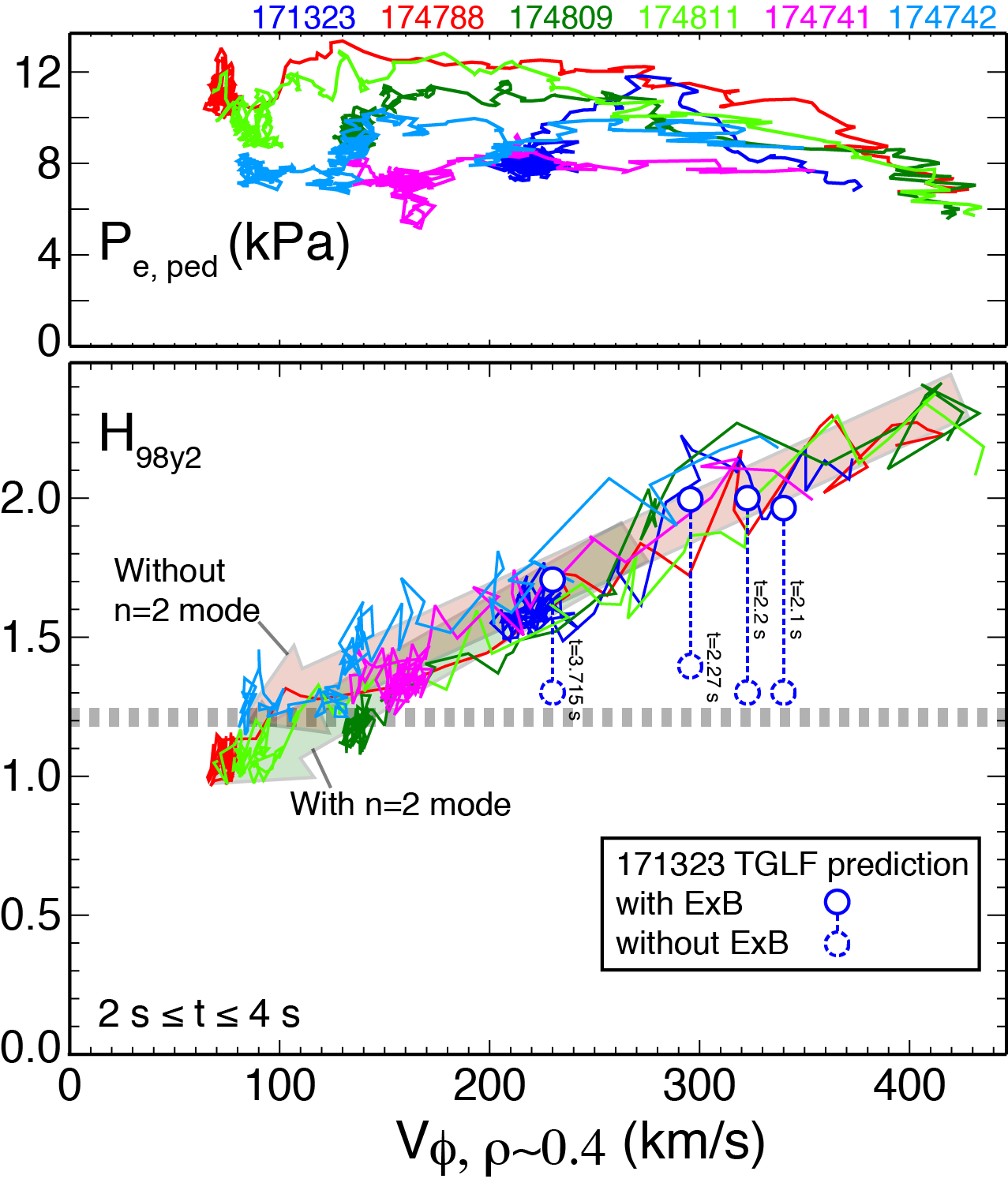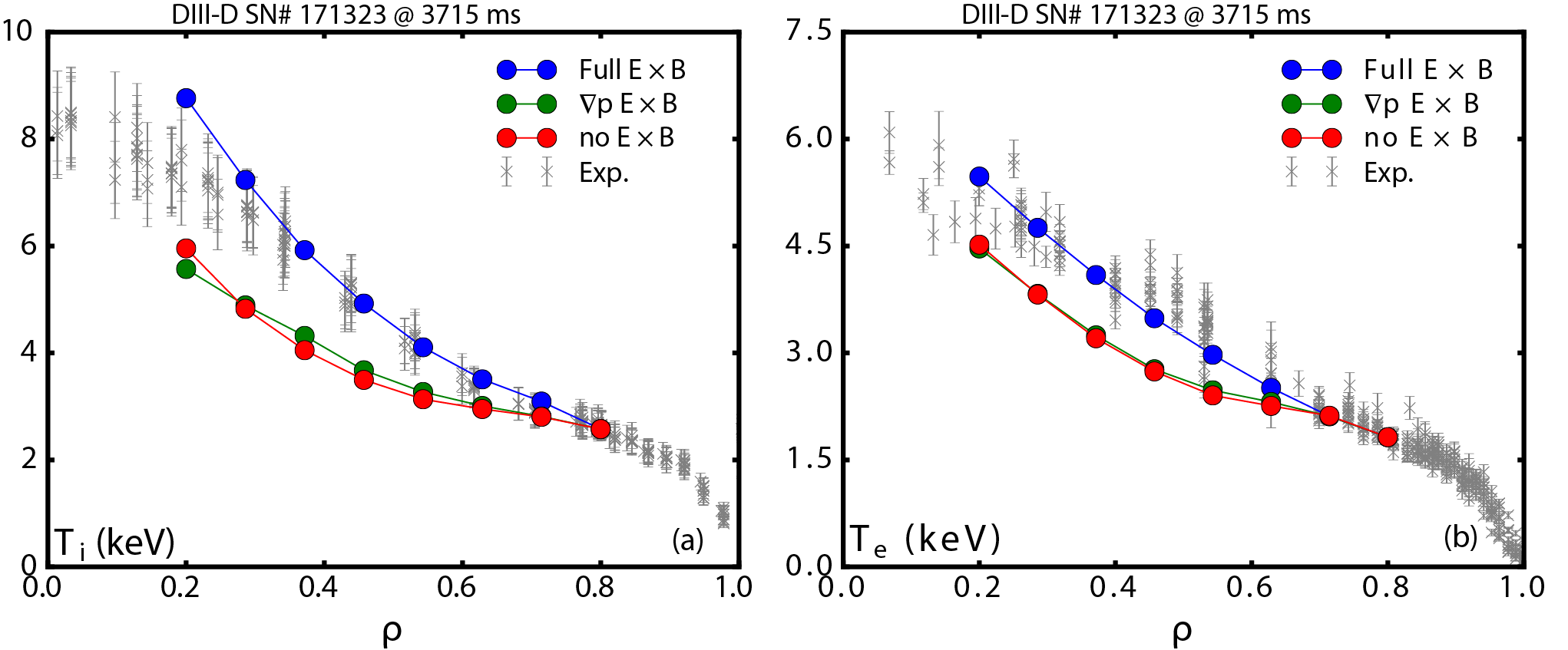Speaker
Description
Analysis of “super H-mode” experiments on DIII-D shows that high rotation, not high pedestal, plays the essential role in achieving very high energy confinement quality ($H_{98y2}$ > 1.5) $^1$. While the stored energy increases as expected with higher pedestal, the energy confinement quality mainly depends on the toroidal rotation (figure 1). At moderate rotation, similar to levels expected in ITER, very high pedestal height only yields marginal confinement quality improvement relative to standard H-mode. The dependence of the thermal energy confinement quality on the toroidal rotation is similar to that observed in the DIII-D advanced inductive scenario (also called hybrid scenario), which is typically characterized by high normalized fusion performance at high rotation, but suffers strong confinement degradation at low rotation $^2$. Linear gyrofluid and nonlinear gyrokinetic transport modeling confirm that the effect of E×B turbulence stabilization is far larger than other mechanisms, including EM stabilization and so-called hot-ion stabilization ($T_i/T_e$), as well as the fast ions effect.

Good confinement is critical for an economical fusion reactor design. Understanding the mechanisms leading to good confinement quality in a particular experimental scenario is essential to the ability to extrapolate that confinement quality to a future reactor. Super H-mode plasmas exploit strong plasma shaping to achieve high edge pedestal pressure at high density $^3$, and often exhibit excellent confinement quality exceeding standard H-mode, i.e. $H_{98y2}$ >> 1.0. It was initially believed that the very high pedestal was responsible for the very high energy confinement quality $^4$. However, careful analysis of the experimental data and transport modeling shows that the reason for the very high H-factor values is the rapid DIII-D toroidal rotation, which does not extrapolate to a reactor.
Figure 1 shows trajectories of several super H-mode discharges illustrating how the confinement quality is linearly correlated with the toroidal rotation in the core, while the pedestal pressure often increases as both the rotation and the confinement quality decrease. Very high confinement is reached early on in the H-mode phase of these discharges, when the pedestal is still low, but after the toroidal rotation has built-up to very high levels in the core. As the discharge evolves, the confinement quality is linearly correlated with the core toroidal rotation, which varies according to different levels of injected neutral beam torque per particle. Note that, even beyond the set of discharges analyzed in this paper, there is no experimental observation of very high confinement achieved at low rotation in any DIII-D super H-mode experiments to date. Also note that, as shown in figure 1, for given rotation the same $H_{98y2}$ is obtained with significantly different pedestal heights (the electron pedestal pressure is used as proxy of total pedestal pressure, since the ratio of electron to ion pedestal pressure stays fairly constant throughout the H-mode phase). Consistent with what one might expect, the stored energy is indeed higher with higher pedestal (not shown in figure), but other parameters (like plasma current, auxiliary power, etc.) must change to yield a different pedestal height, resulting in a constant $H_{98y2}$ for given rotation.
 Figure 2 shows that linear gyrofluid modeling achieves a good match of the experimental observations by including the toroidal rotation and related E×B shear. The temperature reduction that results from removing the E×B effect in the simulation is calculated to decrease $H_{98y2}$ from 1.7 to 1.3. Similar analysis was repeated for several time slices in the same discharge, and all the calculated $H_{98y2}$ with and without ExB effect are reported in Fig.1 (blue circles), showing a similar prediction of the energy confinement quality without rotation, for time slices with different experimental confinement values. Note that all cases without ExB shear are slightly higher than the empirical “low rotation” $H_{98y2}$ (the dashed line shown in Fig.1) and this over-prediction may be due to having a fixed boundary condition at the pedestal in the modeling. Figure 3 shows an example of nonlinear gyrokinetic modeling exploring both the effect of the ExB shear and of the $T_i/T_e$ ratio. A large change in the normalized ion energy flux is predicted when the E×B effect in the simulation is removed. Little effect is predicted when the $T_i/T_e$ ratio is increased from the experimental value during the stationary confinement phase, ~1.16, to the peak value achieved in the discharge, ~1.32.
Figure 2 shows that linear gyrofluid modeling achieves a good match of the experimental observations by including the toroidal rotation and related E×B shear. The temperature reduction that results from removing the E×B effect in the simulation is calculated to decrease $H_{98y2}$ from 1.7 to 1.3. Similar analysis was repeated for several time slices in the same discharge, and all the calculated $H_{98y2}$ with and without ExB effect are reported in Fig.1 (blue circles), showing a similar prediction of the energy confinement quality without rotation, for time slices with different experimental confinement values. Note that all cases without ExB shear are slightly higher than the empirical “low rotation” $H_{98y2}$ (the dashed line shown in Fig.1) and this over-prediction may be due to having a fixed boundary condition at the pedestal in the modeling. Figure 3 shows an example of nonlinear gyrokinetic modeling exploring both the effect of the ExB shear and of the $T_i/T_e$ ratio. A large change in the normalized ion energy flux is predicted when the E×B effect in the simulation is removed. Little effect is predicted when the $T_i/T_e$ ratio is increased from the experimental value during the stationary confinement phase, ~1.16, to the peak value achieved in the discharge, ~1.32.
 In conclusion, super H-mode plasmas can achieve very high energy confinement quality when accessed following a large neutral beam torque injection that transiently drives very rapid plasma toroidal rotation during and shortly after the L- to H-mode transition. As the density increases during the H-mode and super H-mode phases, the rotation decreases. With rotation closer to reactor-relevant levels, most of the confinement improvement over standard H-mode is lost, despite sustained very high pedestal pressure. Further studies on how to improve the energy confinement at low rotation will be key to the development of super H-mode scenario for a high performance fusion reactor.
In conclusion, super H-mode plasmas can achieve very high energy confinement quality when accessed following a large neutral beam torque injection that transiently drives very rapid plasma toroidal rotation during and shortly after the L- to H-mode transition. As the density increases during the H-mode and super H-mode phases, the rotation decreases. With rotation closer to reactor-relevant levels, most of the confinement improvement over standard H-mode is lost, despite sustained very high pedestal pressure. Further studies on how to improve the energy confinement at low rotation will be key to the development of super H-mode scenario for a high performance fusion reactor.
This material is based upon work supported by the US DOE under contracts DE-FC02-04ER54698, DE-AC02-09CH11466, DE-SC0010685, DE-SC0018287, DE-FG02-94ER54235
$^1$ Ding S. et al, 2020 Nucl. Fusion 60 034001
$^2$ Solomon W.M. et al, 2013 Nucl. Fusion 53 093033
$^3$ Solomon W.M. et al, 2014 Phys. Rev. Lett. 113 135001
$^4$ Snyder P.B. et al, 2015 Nucl. Fusion 55 083026
| Affiliation | General Atomics |
|---|---|
| Country or International Organization | United States |
